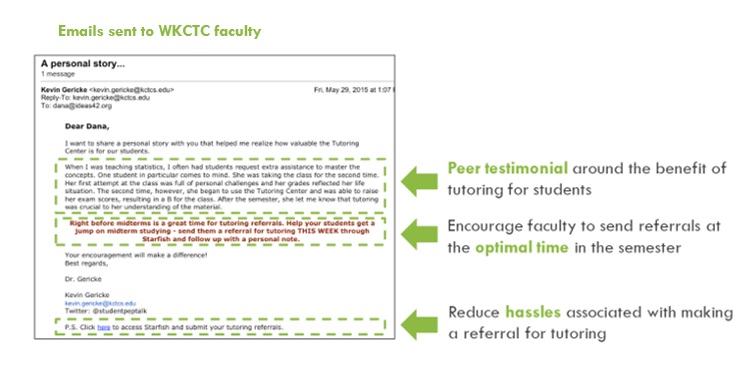
Can an Email Make it Easier to Schedule Tutoring?
Organization : ideas42
Project Overview
Project Summary
Students received a series of nine emails designed to reduce the hassles of using tutoring services and encourage them to take advantage of tutoring earlier in the semester. Additionally, faculty received a series of eight emails discussing how and when to recommend that students use tutoring along with clear instructions for sending tutoring referrals to students.
Impact
Sending behaviorally informed emails to students increased participation in tutoring by almost 2 percentage points, from 5.0% to 6.7%. Additionally, sending behaviorally informed emails to faculty increased the number of tutoring referrals sent to students by over 12 percentage points, from 6.5% to 19.0%.
Cost
It cost $12 for each additional student using tutoring and $31 for each additional faculty member sending at least one referral.
Challenge
At West Kentucky Community & Technical College (WKCTC), many students were failing or withdrawing from courses, but few used the free tutoring services available on campus. Additionally, faculty had the potential to play a large role in helping facilitate student engagement in tutoring services through referrals, but they weren’t involved enough to have an impact.
Design

Emails sent to WKCTC students
To better connect students to campus tutoring services, a series of nine behaviorally designed emails were sent to WKCTC students receiving financial aid. The emails included a list of reasons for attending a tutoring session, simple instructions for scheduling an appointment, and a deadline to help students seek tutoring promptly. Additionally, the emails highlighted use of tutoring by other students, including peer testimonials and success stories, and reinforced the message that good academic standing was required to maintain financial aid eligibility. The emails were sent early in the semester to prompt students to use tutoring before receiving feedback on graded assignment or exams, when it might be too late to benefit from tutoring services.
Another set of emails were sent to faculty members to encourage them to refer students to tutoring. These emails included peer testimonials around the benefits of tutoring for students, a direct link to a communications tool they could use to send referrals, and a suggested time when referrals should be sent.
-

Emails sent to WKCTC faculty members
Impact

A randomized evaluation found that among students who were eligible to use the Tutoring Center, the redesigned emails sent to students increased their likelihood of attending tutoring by almost 2 percentage points, from 5.0% to 6.7%, and increased the overall number of tutoring sessions that were attended from 171 to 263. Additionally, in an online survey, students who received the emails reported more positive perceptions of the tutoring center and were more likely to know how to access its services. Students are considered eligible to utilize the Tutoring Center if they were taking at least one class for which tutoring was offered.
The emails sent to faculty increased the number of tutoring referrals sent by faculty by over 12 percentage points, from 6.4% to 18.9% and helped increased awareness of on-campus tutoring services among faculty members.
Implementation Guidelines
Inspired to implement this design in your own work? Here are some things to think about before you get started:
- Are the behavioral drivers to the problem you are trying to solve similar to the ones described in the challenge section of this project?
- Is it feasible to adapt the design to address your problem?
- Could there be structural barriers at play that might keep the design from having the desired effect?
- Finally, we encourage you to make sure you monitor, test and take steps to iterate on designs often when either adapting them to a new context or scaling up to make sure they’re effective.
Additionally, consider the following insights from the design’s researcher:
- We noticed that the tutoring center was located away from most student life. When the opportunity presents itself, we encourage administrators to make tutoring centers visible, salient, and integrated into other student activities. Tutors could venture out of the tutoring center to meet students where they usually are–in the library, in dining halls, and even in the classroom.
- While the intervention encouraged students to take up tutoring services, the actual scheduling process felt outside of our intervention parameters. Students may have encountered additional hurdles with the scheduling process itself. We encourage any schools implementing an intervention like this to also simplify or streamline the scheduling process.
- As with any type of program implementation, details are key. Double and triple checking implementation materials and protocols, and having multiple people participate in this process will help avoid small mistakes that could diminish the effectiveness of your program or compromise an evaluation. We had multiple people review email drafts and conducted tests of each email to ensure that links were functioning and formatting was delivered correctly across multiple email platforms and internet browsers.


